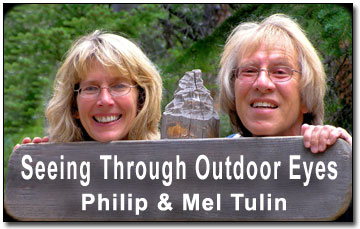|
Last September during the Elk Rut, we were standing next to about a dozen photographers who were using 800mm (or greater) lenses on tripods. We were not using tripods so we could move about quite easily. After about an hour, one photographer asked what we were using for equipment. We showed him our camera and then said, "Would you like to see some of the pictures
 from our portfolio that is in the car?" They all said, "Yes!" and we showed them about 40 11"x14" photographs of birds, wildlife and some landscape. They passed our photographs
slowly from person to person. Their reaction was all the same, "What detail in the bird's feathers!" We were standing next to $100,000+ worth of equipment and all they wanted to see and hold and inquire about were our $250 cameras.
from our portfolio that is in the car?" They all said, "Yes!" and we showed them about 40 11"x14" photographs of birds, wildlife and some landscape. They passed our photographs
slowly from person to person. Their reaction was all the same, "What detail in the bird's feathers!" We were standing next to $100,000+ worth of equipment and all they wanted to see and hold and inquire about were our $250 cameras.
The secret to obtaining award winning photographs is within us and "It's Not About The Camera." It's about you and me.
Many articles have been written on the limitations of any creative craft based on the tools available. We do not believe in that concept because it seems to impose a distinct limitation on the creative process. The emphasis has always been about the tools available and not about the inner mind's creative eye. Why does the Beatle's album of Sgt Pepper's Lonely Hearts Club Band still set a standard today when the album was recorded in 4 track studio? Why does the photography of the past create such an emotion with people today?
You can forget about your conventional tripod, your bulky camera bags, your padded backpacks, your multiple lenses and an expensive camera body. With "Travel Light & Travel Simply", you will learn how to use the minimum to get the maximum photography opportunities... while still balancing the in-the-moment nature experience. If you ever read about William Henry Jackson, one of the best-known early landscape photographers, you would have learned the difficult process he had to endure to photograph his pictures. He had to travel by horseback, then by mule and his equipment weighed over 300 pounds. He had to unload the equipment, set up camp, prepare the glass plate and on and on. Yet, even today, his photographs are still of exquisite beauty. He really knew how to use the minimum to produce the maximum. Fortunately, we do not have to haul around 300 pounds of photography equipment. This week we saw a photographer at Estes Lake carrying a tripod with a 2 foot long lens, wearing a belt with 4 lens cases wrapped around his waist and a camera bag hung over his right shoulder. By the time he set up his equipment to photograph a bird, we had nailed 10 photos of the bird and the bird had already flown away.
If you had a $5,000 set of golf clubs and Tiger Woods selected 2 clubs and a putter, who would end with the better score after 18 holes of golf? Does the equipment make the difference or is it the talent that makes the difference? We would take Tiger's talent over expensive golf equipment every time! Success in golf is measured by the score at the end of the round of golf. They don't write next to the score that someone used 3 clubs or a $5,000 set of golf clubs. You look at the number and say, "That person is a talented golfer!"
How do YOU measure your success in photography? There are basically 2 ways to measure success; personal satisfaction and financial/publication satisfaction. The first way only you can decide if the results meet your expectations. The second way is with the number of photographs that you sell, how often they are seen in magazine/newspaper articles and on magazine covers, people recognizing your name or your photograph, etc. We have succeeded in the second way. Did any publisher ever say to us, "What camera did you use and how much did the camera cost?" Never as they were always interested in the results, not the equipment used.
We set out to develop our own style of photography and we named it "On-The-Go Photography" (OTG). OTG seems to imply a conflict of terms. How can a person be On-The-Go and still produce great photographs? Why must great photographers always have to wait and be patient? OTG Photography is for the person who wants to balance photography with the in-the-moment nature experience. Once a photograph becomes the main objective, the in-the-moment nature experience becomes secondary. We didn't want to lose the experience of enjoying the great outdoors. OTG Photography is for the person who wants to "Travel Light & Travel Simply" and also wants to take great photographs.
We admit... there will be some limitations with OTG Photography. But that occurs in every situation. You will not always end up with a perfect photograph and you will miss out on some great photography opportunities. But, you will see more, learn more and you will enjoy photography more because you will maintain that fine balance of seeing nature, being a part of nature and trying to take the perfect photograph.
OTG Photography is an art form that has to be learned and practiced. But, the main ingredient in the process is that you, the photographer, have to be comfortable in traveling light and traveling simply. OTG Photography complements your existing style of photography. It is not meant to replace it. In future articles, we will learn about OTG photography.
| 
